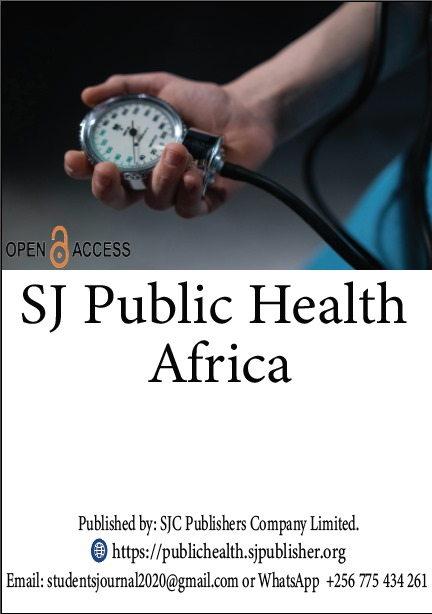Level of COVID-19 vaccine uptake and associated factors among adults in Kayunga police barracks. A cross-sectional study.
DOI:
https://doi.org/10.51168/dfrzs376Keywords:
COVID-19, vaccine uptake, Kayunga police barracksAbstract
Background
The COVID-19 pandemic has affected more than 200 million people, causing loss of life and livelihood across the entire world, which accelerated the development of COVID-19 vaccines. Therefore, this research investigated the level of COVID-19 vaccine uptake and factors associated with the COVID-19 vaccine in Kayunga Police Barracks.
Methods
It was a cross-sectional study in which 100 respondents were interviewed. Multi-stage sampling was used to select respondents who were 18 years or older at the time of the visit. Quantitative data were collected and entered into Excel and analyzed using SPSS version 26. Odds ratios were used as the measure of association, with corresponding 95% confidence intervals.
Results
A total of 100 respondents participated in this study. Most 48% (48%) of the study participants were in the age category of 18 to 30 years. The majority, 56% (56) ,were females, more than half of the participants, 55% (55), were educated, and almost 78% (78) were employed. About 39.2% of adults in Kayunga Police Barracks had not taken the COVID-19 vaccine. Most, 83% (83) of the respondents didn’t know the benefits of taking the COVID-19 vaccine, and 94% (94) didn’t know where to find a health center that manages cases of COVID-19. Findings confirm that adverse effects following immunization (AEFI), mistrust of authority, and perceived severity of COVID-19 symptoms are factors that were statistically significantly associated with adults not taking the COVID-19 vaccine.
Conclusion
39.2%of adults in Kayunga Police Barracks had not been vaccinated against COVID-19, and factors, adverse effects following vaccination, mistrust in Authority, and perceived severity of COVID-19 symptoms, were the factors associated with low COVID-19 vaccine uptake in Kayunga Police Barracks.
Recommendation
Continuous Monitoring and Evaluation: Establish a robust monitoring and evaluation system to track vaccination rates and identify any emerging challenges or barriers.
References
Bamulanzeeki, 2021. Uganda starts COVID-19 vaccinations. [Interview] 2021.
Cucinotta and Vanelli, 2020. WHO declares COVID-19 a pandemic., s.l.: Acta Biomed.
Kasozi et al, 2021. A Descriptive-Multivariate Analysis of Community Knowledge, Confidence, and Trust in COVID-19 Clinical Trials among Healthcare Workers in Uganda. Vaccines.
Kasozi et al, 2021. A Descriptive-Multivariate Analysis of Community Knowledge, Confidence, and Trust in COVID-19 Clinical Trials among Healthcare Workers in Uganda. Vaccines, 253(;9(3):Available from: https://www.mdpi.com/2076-393X/9/3/253.).
MacIntyre, 2020. CR. The global spread of COVID-19 and pandemic potential. Research gate, Volume 1.
MOH, 2020. Update on COVID-19 response in Uganda, Kampala: Ministry of Health.
Mohamed et al, 2022. Exploring Challenges to COVID-19 Vaccination in the Darfur Region of Sudan. The American Society of Tropical Medicine and Hygiene, 1(123), pp. 17-20.
Rochwerg et al, 2020. A living WHO guideline on drugs for COVID-19, BMJ.
WHO Africa, 2021. Rising mortality as Africa marks one year of COVID-19 .. [Online]
Available at: https://www.afro.who.int/news/rising-mortality-africa-marks-one-year-COVID-19
[Accessed Friday, July 2021].
WHO, 2021. COVID-19 situation report for the WHO Africa, Brazzaville: WHO.
WHO, 2021. Daily COVID-19 updates. [Online] [Accessed Thursday July 2021].
WHO, 2021. World Health Organization. Coronavirus disease (COVID-19 ) weekly epidemiological report, Geneva: WHO.
Willis 2021. COVID-19 vaccine uptake: race/ethnicity, trust, and fear. Clin Transl Sci., p. 8.
Worldometers, 2021. Covid live update. [Online] [Accessed Saturday, July 2021].
worldometers, 2021. worldometers. [Online]
Available at: https://www.worldometers.info/coronavirus/country/uganda/
[Accessed Friday 2, 2021].
Zimmer and Corum, 2020. Coronavirus vaccine tracker US: The New York Times; 2020 [cited 2020 December 13]. Available from: https://www.nytimes.com/interactive/2020/science/coronavirus-vaccine-tracker.html. [Online] [Accessed Thursday July 2021].
Fontanet A, Cauchemez S. COVID-19 herd immunity: where are we? Nat Rev Immunol. 2020 Oct;20(10):583-584. doi: 10.1038/s41577-020-00451-5. PMID: 32908300; PMCID: PMC7480627.
Downloads
Published
Issue
Section
License
Copyright (c) 2025 Lilian Nafuna , Dr. Twa-Twa Mutwalante Jeremiah (Author)

This work is licensed under a Creative Commons Attribution-NonCommercial-NoDerivatives 4.0 International License.
The journal publishes under the Attribution-Noncommercial-NoDerivatives 4.0 international (CCBY-NC-ND 4.0) license which allows you to Share, Copy and redistribute the materials in any medium or format. The licensor cannot revoke these freedoms as long as you follow the license terms;
- Attribution: You must give appropriate credit, provide a link to the license, and indicate if changes were made. You may do so in any reasonable manner, but not in any way that suggests the licensor endorses you or your use.
- Non-commercial: You may not use the material for commercial purposes. Commercial use is one primarily intended for commercial advantage or monetary compensation.
- No Derivatives: if you remix, transform, or build upon the material, you may not distribute the modified material.
- No additional restrictions: You may not apply legal terms or technological measures that legally restrict others from doing anything the license permits.




